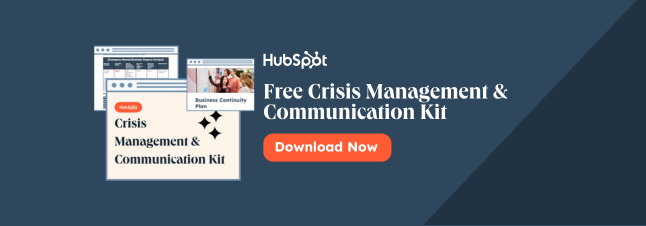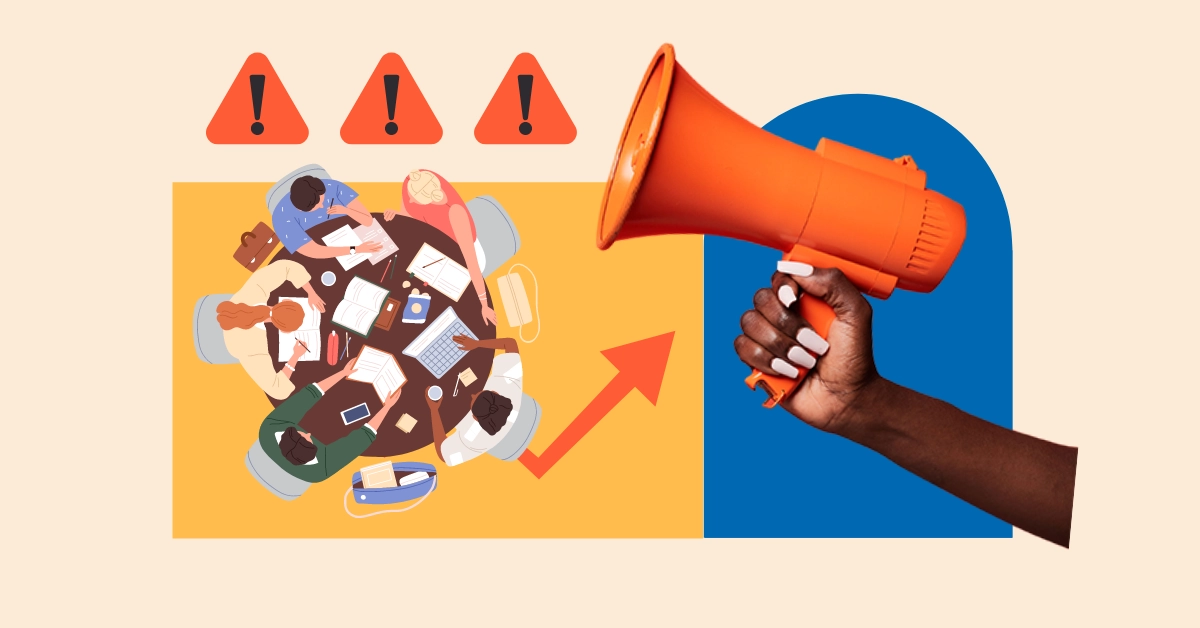Running a business would be much easier if every negative situation came with prior warning. Instead, business leaders are typically left to mitigate the reputational risk that comes during the aftermath of a worst-case scenario. Sound familiar?

In this post, we’ll outline what these types of unexpected risk scenarios are, explain how to rebuild your business's reputation, and give tips on putting your best foot forward in the eyes of your customers.
Free Download: Crisis Management Plan & Communication Templates
What is reputational risk?
Reputational risk is any sort of threat or danger that can damage the good standing of your business and negatively impact your reputation with consumers and overall business success. These risks are typically unexpected and can occur with little to no warning.
Why is reputational risk important?
All reputational risks typically cause consumers to lose confidence in your business, which negatively impacts all areas of operation; trust of employees and consumers, customer satisfaction, customer retention, revenue generation, and more.
Social media has made reputational risk scenarios even more dangerous for businesses as consumers can quickly (and easily) take to their accounts and share negative experiences with global audiences. In addition, breaking news sources can also easily disseminate information on multiple platforms.
With reputational risk you're up against several battles including speed, reach, and optics. However, there are several types of risk and each one comes with its own risk management strategy. Next, let's look at these types of risk and what makes each potentially damaging to the reputation of your business.
Types of Reputational Risk
There are four main types of reputational risk:
1. Actions of the Company
These reputational risk scenarios are caused by direct actions of your company and company practices. Some possible example scenarios include:
- Not complying with regulations, like federal or local laws or industry regulations
- Data breaches due to unsafe practices that threaten the personal information and safety of consumers and employees
- Consistent inability to meet customer needs or falling short of customer expectations
- Legal actions involving your business that become public knowledge
- Layoffs and internal scandals that become public knowledge
- Poor working conditions for employees or exploitative working conditions
- Poor quality products and services
- Purposeful misaction that consumers become aware of
Whether the company action was intentional or not, this type of risk can affect the way public entities view your business. This can bring about negative press and even government scrutiny if decisions your company makes are regulated by a governing body. This type of risk can potentially cost millions of dollars in litigation fees and corrective action.
2. Actions of Company Representatives
These risks typically occur because someone with direct ties to your business acts unacceptably, or engages in unethical or immoral practices. Here are some possible scenarios:
- C-Suite employees engaging in unethical conduct
- Business leaders with negative reputations, or that develop negative reputations through specific actions
- Employees involved in misconduct that becomes publicly known
- Employees poorly representing your brand to others
- Individual employee misconduct towards customers
- Negative social media posts by those associated with your business
Although it might be tempting to think that actions of company representatives and employees are not actions of the company, the public likely won't agree. Since businesses don't have personalities or faces, its representatives fulfill that role. This opens any organization up to a host of liability and reputational risks.
3. Actions of Partners
Partners and suppliers often provide critical support that helps businesses run, but their behavior can pose a reputational risk to your business, especially if you have an established relationship. Here are some possible scenarios:
- Partner experiencing service interruptions that critically affect a pillar of your business, like malfunctioning software
- Partners or suppliers engage in misconduct that becomes public knowledge
- Partners or suppliers speak negatively about your business
Depending on how closely tied your business is to partners and suppliers will determine how much of a risk to your reputation their actions can be. This is also true with marketing partnerships, influencers, sponsorships, and advertisers.
4. External Actions
External actors like customers and past employees can have a significant impact on your business reputation, especially if they have a bad experience. Some example scenarios include:
- Negative social media posts from consumers about their experience with your business
- Negative reviews left by customers on public review sites, especially if based on false experiences
- Negative articles and press about working conditions as told by past employees
- Attacks on computer systems or data breaches
This type of risk carries a lot of weight with the media and potential customers because it helps them form an opinion about how people are treated after they've received goods, services, or employment from your company. Does your organization stay true to its values or is it apathetic toward (or completely disregard) those values once the job is done?
The possible situations listed above are just examples of reputational risk scenarios that can cause serious damage to your business. Next, let’s go over some real-life examples of experiences businesses have had that put their reputation at risk.
How to Mitigate Reputational Risk
Mitigating reputational risk involves lessening the blow when a threat occurs, essentially getting out in front of the problem. Acknowledge that it is occurring, and have PR teams create crisis messaging that will help your business explain what is happening to consumers. Explain what you’re going to do about the issue, and, most importantly, be transparent.
Although not every reputational risk can be predicted, there are measures you can take to prepare for a worst case scenario and prevent it before it happens. Here are a few ways you can mitigate reputational risk.
Honor your core values.
The first method of preventing reputational risk is to lean on the core values of your organization. You can include the mission and vision in your decision making, too. By relying on these building blocks of your company culture, you can not only shield it from harm, you can double down on your choices internally and externally because they will align with the purpose the founders had in mind when building the company.
If you're leading a new company or building a startup, check out these tips for developing an authentic set of core values, an inspiring mission statement, and a forward-thinking vision statement.
Require internal compliance training.
Although some risk reduction measures may seem like common sense to some of your employees, especially those in leadership, it's a good idea to have all employees of your company (and even contractors, if possible) take a course or complete a knowledge check on company policies around social media, press, and speaking about the organization in public. In other words, your employees should do a compliance training session. The more transparent you can be about what you're requiring of your team and why, the better off you'll be in managing reputational risk.
Use social listening tools.
Keeping your metaphorical ear to the streets is another way to prevent potential risks or diffuse those that are starting to gain traction on the web. Tools most notably used for social media, like Sprout Social, are perfect for spotting conversations that may position your brand in an unsavory light. But you'll want to have a plan for addressing these issues, too.
It's not wise to go into a conversation between unhappy customers and prove them wrong or explain yourself. Rather, consider these smart ways to handle disgruntled customers and turn them into brand advocates.
Invest in public relations.
Finally, when you've exhausted each of these efforts but still find your company in hot water with the public, it's time to remedy the situation. Public relations and marketing are the best ways to get your brand back in the good graces of customers, employees, and other stakeholders who may be turned off by recent changes in your reputation.
Public relations isn't about spinning a narrative in your organization's favor, but instead making a good-faith effort to meet your stakeholders where they are and make the best decisions using the most accurate information available to you at the time. Get started with a positive PR strategy with this comprehensive guide.
Reputational Risk Management
Reputational risks are often unanticipated and surprising, so there is no specific way to plan for them. However, the contingency plans that your business should already have created and consistent reputation management will help you deal with situations if they occur.
These plans you’ve created likely outline individuals responsible for taking immediate action, and sample action items to be followed. If you were to experience a threatening situation, responsible individuals can act on the existing plans and tailor the response to the specific risk at hand.
For example, if the risk situation is an explosive tweet by a former employee, your baseline crisis management plan may be adapted for a social media response.
Download the Crisis Management & Communication Kit
In addition to general crisis management, standard business practices that lessen the likelihood of reputational risk scenarios occurring are all things that your businesses should already be doing, like:
- Prioritizing customer relationships and customer satisfaction.
- Listening to customer feedback and acting on their needs.
- Compliance with legal rules.
- Managing conversation about your business online (like responding to Google reviews).
- Safe storage of consumer and employee information, especially when collecting secure financial information.
- Consistently monitor product quality.
- Maintaining safe work environments for employees, both physically and mentally.
- Internal groups conduct routine checks of all business operations to identify possible risk areas or areas for improvement.
- An understanding that everything and anything can affect public perception of your business and has the potential to risk your reputation.
Reputational Risk Examples
Kendall Jenner and Pepsi
Reputational risk caused by direct actions of your company and company practices.
Pepsi Cola, a soft drink company, released an advertisement with Kendall Jenner, an American celebrity, in 2017. In the ad, Jenner attends a protest and hands a can of Pepsi to a police officer as a peace offering.
Consumers were immediately outraged, as they felt the ad trivialized the Black Lives Matter movement and widespread protests of police brutality that were happening that year. Many interpreted the ad to say, “All it takes for us to get along is to share a can of soda,” ignoring the years of systemic oppression felt by marginalized communities.
Pepsi pulled the ad and apologized, but it damaged their reputation and standing with American consumers as the brand experienced nine months of the lowest perception levels it had seen in eight years. In addition, approval ratings with millennials, a generation with significant purchasing power, fell, too.
Jenner experienced similar fallout, as consumers believed her apology was insincere. Her participation in the advertisement is still referenced frequently on social media channels almost six years later and has become somewhat of a meme. An article was even published in May of 2021 titled “Here's Why Kendall Jenner Will Never Escape The Backlash From That Pepsi Commercial.”
McDonald’s and Stella Liebeck
Reputational risk caused by external factors and direct business action.
79-year-old Stella Liebeck bought a cup of coffee from fast-food chain McDonalds in 1992 and experienced third-degree burns after it spilled in her lap. Liebeck sued McDonald’s for damages in court, which put the business’s reputation at risk because of the publicity of the lawsuits.
During the trial, McDonald’s admitted to knowing about the risks posed by the high temperature of its coffee but had not taken any sort of action. As mentioned above, a business’s purposeful lack of action is viewed as negligence by consumers, a significant cause of reputational risk. External factors, namely press and articles that outlined the lawsuit for the general public, also threatened the business reputation.
Uproar from this specific event has died down today. Still, McDonald’s has shown commitment to rebuilding public trust through actionable steps like providing significant warnings about liquid temperature and serving hot drinks in sturdy foam cups that are less likely to tip over.
Shein and Clothing Suppliers
Reputational risk caused by actions of suppliers and partners.
The Chinese fast-fashion giant, Shein, stepped onto the scene in 2008, but has been widely popular in the last five years. The inexpensive clothes paired with quick shipping made it an accessible site for consumers to purchase the latest trendy pieces on a budget. But this convenience came with a price.
In recent years, major news outlets and documentaries have reported on the unsafe and unfair working conditions that Shein suppliers and manufacturers endure to produce the clothing at an expedited rate. But why the rush? Shein relies on influencer reviews to sell products. With social media apps like TikTok and Instagram delivering content at a dizzying pace, fashion trends come just as fast as they leave which only puts pressure on the supply chain operation at Shein.
In late 2022, Shein made a commitment to pledge $15 million to improve standards at its supplier and manufacturing warehouses.
Over To You
As reputational risk scenarios are sometimes unexpected, the best way to be prepared is to practice consistent crisis management by creating actionable plans and taking immediate action if and when a scenario arises.
As Warren Buffet says, “It takes 20 years to build a reputation and five minutes to ruin it. If you think about that, you'll do things differently."
Editor's note: This post was originally published in [Month Year] and has been updated for comprehensiveness.



![De-Escalation Techniques: 30 Proven Strategies to Diffuse Tension and Build Trust [Expert Tips + Data]](https://www.hubspot.com/hubfs/de-escalation-techniques_2.webp)




![Social Media Crisis Management: Your Complete Guide [Free Template]](https://www.hubspot.com/hubfs/social-media-crisis-management-1-20241107-3106355.webp)

